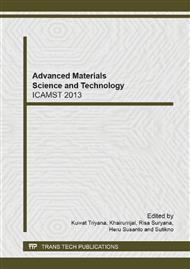p.464
p.468
p.472
p.477
p.481
p.485
p.489
p.493
p.497
Influence of Mass Ratio of Aquadest and TTIP on the Synthesis of TiO2 Nanoparticles to Improve the Performance of DSSC with Beta-Carotene as Sensitizer
Abstract:
TiO2 nanoparticles have been successfully synthesized using the sol-gel method with main materials of titanium tetraisopropoxide (TTIP) and HClO4 solutions. Mass ratios (Rw) of aquadest and TTIP were 0.85, 2.00, and 3.50 which were going to be investigated in crystallization of TiO2 phases. Pre-heating was performed on TiO2 at 60°C for one day then it was annealed at 150°C for 3 hours. The DSSC structure was formed by using the synthesized-TiO2 as semiconductor material and beta-carotene as dye sensitizer. The x-ray diffraction (XRD) spectrum indicated that TiO2 peaks had anatase phases on crystal orientation of (101), (004), and (200) while TiO2 of rutile phase only appeared on orientation of (211). The highest intensity for all Rw was dominated by (101) anatase phase. From XRD spectrum data of (101) peak, the Scherrer’s method predicted that crystal size of TiO2 was 3.48 nm, 4.36 nm, and 4.47 nm for Rw of 0.85, 2.00, and 3.50, respectively. The Tauc’s method was applied on the UV-Vis data that predicted the bandgap energy (Eg) of TiO2 for Rw of 2.00 (Eg=3.14 eV) was higher than Rw of 0.85 (Eg=3.02 eV) and 3.50 (Eg=3.04 eV). The I-V characteristic calculation of DSSC structures were obtained that the efficiency optimum is 0.01% for Rw of 2.00. It is considered that bandgap energy value correlated to stability of Ti-OH bonds that caused the exited-electrons are easily injected to conduction band of TiO2. The performance of DSSC using the synthesized-TiO2 which consists of anatase and rutile can be improved about ten times compared to that using the pure-TiO2 rutile.
Info:
Periodical:
Pages:
481-484
Citation:
Online since:
February 2014
Authors:
Keywords:
Price:
Сopyright:
© 2014 Trans Tech Publications Ltd. All Rights Reserved
Share:
Citation:


